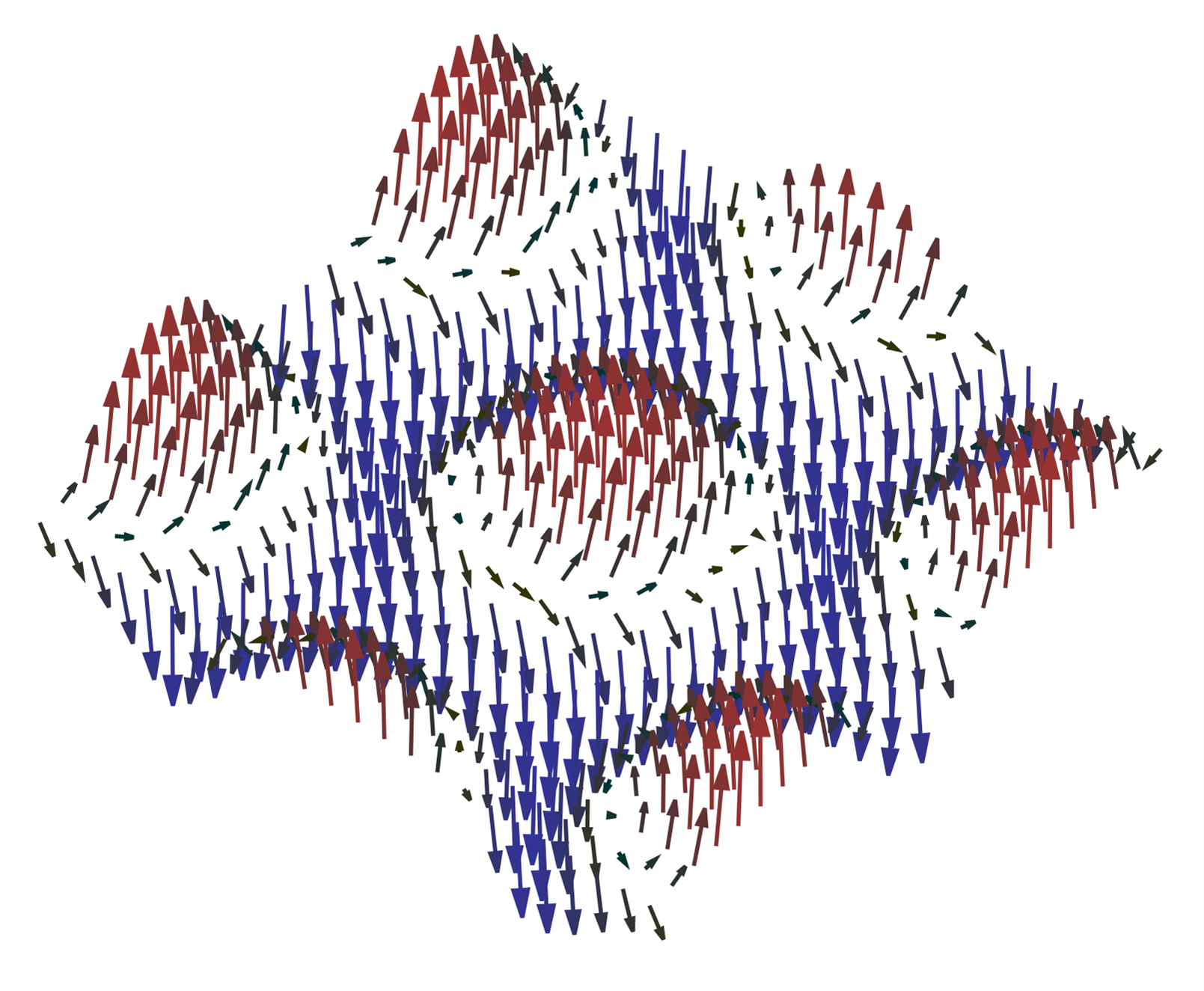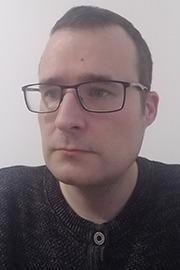Please could you introduce yourself and your professional background?
TW: My name is Tobias; I am originally from Germany and I have been working as a computational physicist at the Institut Laue-Langevin (ILL) in Grenoble since 2017. I had already begun work on investigating manganese silicide (MnSi) during my Ph.D. thesis, and the current work on skyrmions in MnSi is a continuation of my interest in this topic. The work I do at ILL is underpinned by a large collaboration with theorists and experimentalists based everywhere from Munich to Oxford to Switzerland.
PS: I’m Paul and I’ve been working alongside Tobias throughout this process as a physicist with a special interest in magnetism. I’ve worked at the ILL since 2007 as an instrument scientist, and together Tobias and I designed and ran the experiments on MnSi using neutron scattering experiments at the cutting edge of their capabilities.
Could you explain what magnons and skyrmions are?
Magnons are the quantized magnetic excitations that act like particles and can spread through certain magnetic materials like a crowd wave at a football stadium. Skyrmions are particular vortex-like magnetic configurations that form in specific materials, such as manganese silicide. The skyrmions extend along tubes, a bit like a box of uncooked spaghetti, with tightly packed arrangements of magnetic vortex tubes in long straight lines stretching in both directions.
The skyrmion formation was proposed over 50 years ago by Tony Skyrme as a model of the nucleon, but recently interest in this area has greatly increased due to its quantum computing potential.

In a skyrmion lattice, the magnetic moments are arranged in a vortex-like fashion. Image Credit: T. Weber
What makes magnons a better transporter of information than electrical conductors?
When information is transferred in electronics, the resistance of the wires produces heat as a by-product. Understanding the behavior of magnetic spin waves could unlock an alternative route for transferring data that uses magnons and avoids the wasted heat that we see in electronics.
Why does the generation of heat negatively affect information transfer?
Heat produced from electronics is a huge problem for our technology-dependent world. The energy costs involved in cooling large electronics systems are huge and impact both the environment and the economy. For example, a recent study has shown that operators of large data centers like those for major tech companies spend billions of dollars a year on cooling systems for computers – up to 40% of their energy demand. At high temperatures, electronics will also stop working, as high resistance reduces the conductivity of wiring.
Can you explain what you have found with regards to magnetic spin waves?
This research focused on skyrmions, and showed that in this particular magnetic configuration in materials, the magnetic spin waves behave like electrons. They closely mimic the motion of electrons in response to a magnetic field, meaning that their movement may be predicted more accurately and exploited for future technologies, such as data transfer, or quantum computing. We identified a novel circular spin-wave motion around skyrmions, representing a major step-change in our understanding of magnons.
How does the propagation of these waves differ in different materials? How does this relate to skyrmions?
The circular motion is caused by a quantization of the allowed magnon energies on so-called Landau levels (discrete magnon bands that are almost equidistant in energy values). In other materials that feature a skyrmion phase, the shapes and energy spacing between these levels will vary. Because of this uniformity in Landau levels, more information can be deduced about their characteristics - like magnetic field structure and predicted energy levels - than in other materials.
How could this result in the application of this phenomenon in quantum technology?
It is hoped that once further characterization and analysis of magnons is completed, their properties can be harnessed and programmed into technology. Control of these properties at this sub-atomic level will mean that energy can be transferred in a more efficient manner, allowing eventually for smaller and more efficient quantum devices to be developed.
Which of these materials would be best suited for applications in quantum technologies?
The material investigated in this research was manganese silicide (MnSi), a mineral that was discovered in cosmic dust from a comet. It is the archetypal model for studying skyrmions, as the energy scales of the magnons are perfectly suited for observing them in neutron experiments.
We can only perform experiments with this material at extremely low temperatures however, so finding a material with similar magnetic properties at room temperature is the next step to unlocking future applications.

Image Credit: spainter_vfx/Shutterstock.com
What makes neutrons well suited for the study of magnetic materials and skyrmions?
As a fundamental particle with its own magnetic moment, neutron scattering is the only technique that could respond to the magnetic fields of the skyrmions – like a compass needle detecting the North Pole.
Therefore, using inelastic neutron scattering to analyze the skyrmion phase of MnSi was invaluable. With the largest neutron flux in the world, neutrons available at the world-leading facility, the Institut Laue-Langevin in Grenoble, France, provided a far more detailed picture of magnonic wave propagation than other experimental techniques available.
How does the vortex-like structure of skyrmions affect the spontaneous motion of spin waves on circular orbits?
This is difficult to answer in a few sentences! However in general, the motion of spin waves always depends on the magnetic structure, so in the particular case of a vortex structure, the motion of spin waves is influenced accordingly.
What are the implications of this research for quantum technologies?
Magnons are already being seen as a crucial aspect of spin-based quantum computing, and a greater understanding of their properties is needed to exploit their nature for our own applications. The theoretical possibility of using skyrmions for the construction of quantum logic gates was discussed in very recent work.
This study demonstrates how skyrmions could be programmed to form a fundamental component of a quantum processor, called a quantum logic gate. Adjusting the states of the skyrmion using magnetic fields is possible and the results of this will offer a sophisticated operational function within a quantum processor.
In your opinion, what is the most exciting aspect of this research?
For me, it was exciting to work in such a large collaboration, involving researchers from ILL, the spallation source SINQ in Switzerland, the ISIS Neutron and Muon Source in the UK, and the Research Neutron Source Heinz-Maier-Leibnitz (FRM II) at the Technical University of Munich.
The process required experts from several disciplines operating all major types of neutron spectrometers to obtain complementary data, including triple-axis, time-of-flight, and spin-echo instruments. In order to resolve the closely-spaced Landau levels, each instrument operated on the limits of what is technically possible today.
What I find exciting about the results is that we see very fundamental phenomena, which most likely determine the behavior of many materials, but which until now had been too complicated to observe and to understand, making this an immense achievement.
More from AZoQuantum: A Unified Theory of the Universe with Quantum Gravity
Where can readers find more information?
About Tobias Weber and Paul Steffens
T. Weber:

- Studied physics at TU Munich and practical computer science at FU Hagen.
- Started at the ILL in 2017, originally as instrument co-responsible for a triple-axis spectrometer, later in the scientific computing group.
- Current projects involve studies of magnetic systems, neutron scattering simulations, and autonomous instrument control.
P. Steffens:

- Studied physics at the University of Cologne, Germany.
- Since 2007, a scientist in the spectroscopy group and instrument responsible at the Institut Laue-Langevin.
- Currently developing an energy-dispersive multi-channel detector for the Thales spectrometer.
Interview questions provided by Robert Lea.
Disclaimer: The views expressed here are those of the interviewee and do not necessarily represent the views of AZoM.com Limited (T/A) AZoNetwork, the owner and operator of this website. This disclaimer forms part of the Terms and Conditions of use of this website.